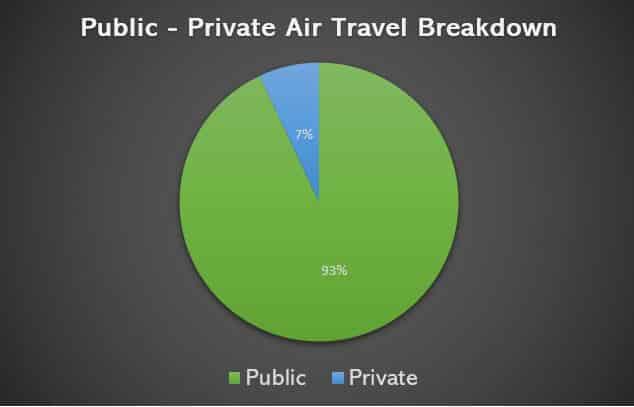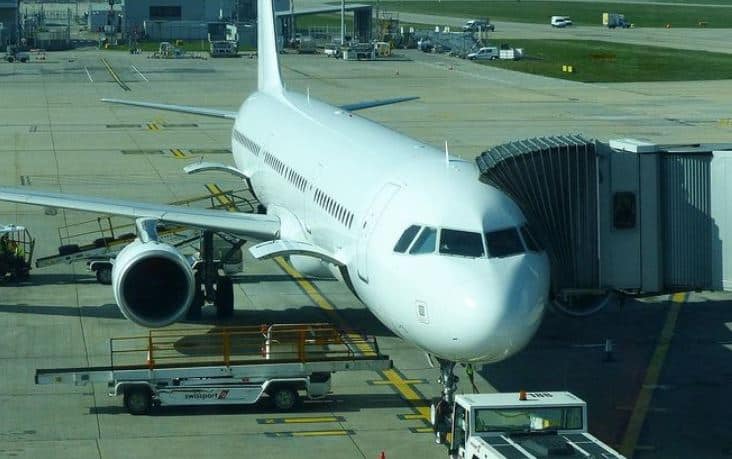Planes count as public transport if they are operated by an airline that carries fare-paying passengers. However, there are other forms of transport carried out by an aircraft which would not be classed as public transport.
How are Planes Defined as Public Transport?
As mentioned already, planes typically are categorized under public transport if members of the public or fare-paying passengers are onboard. This could also be regarded as public transport since airlines publicly advertise and sell tickets for flights.
Aside from how airlines sell their tickets to their passengers, it’s a form of public transport in the fact that an airline’s fleet of aircraft is configured to carry a significant amount of people from one place to another. This group of people will travel in a shared space (an aircraft).
Private Forms of Air Travel
For most of the population, air travel is classified as public transport. However, a small minority have the luxury and means to travel on aircraft privately. Private jets involve the hiring or “chartering” of an aircraft to transport an individual or small group of people from one place to another.
Passengers typically pay on a per-hour basis, at a sum that is exponentially greater than that of which airline passengers pay.
However, there are several advantages to using this service. Private jet passengers may go wherever they want, whenever they want. This is especially useful for those who need to use their time efficiently (businesspeople etc).
It is estimated that just 7% of the world’s global daily flights are private jets, the other 93% being a mix of scheduled airline services and cargo flights.
Breakdown of Air Travel
The remaining 93% of daily flights on a global scale typically amount to about 165,000 flights on average. Of this 93%, the majority consists of scheduled passenger airline flights.

Why Do Most Planes Count as Public Transport?
The primary reason for most air travel falling under the category of public transport is the market demand for affordable and accessible transport between two places which may be difficult to access via other means of transport.
From a commercial perspective, airlines see the demand in the market and then serve it with air services for which passengers can purchase tickets.
It is much more commercially feasible to transport a large group of people on one aircraft than it is to transport individuals on a singular basis. As a result, airlines offer air services on routes that are in demand from the public.
This market of public transport is especially lucrative on routes which are high density, in which there is a huge market demand from the public.
Aside from operating air services for profit, some airlines will also operate public air routes on behalf of a local government. These flights are generally subsidized by the respective authority with the sole intention of connecting areas that are either inaccessible by road or are reliant on air travel.
These instances usually concern remote areas which have little or poor road infrastructure and require connectivity to the larger regions of a country or state. In these areas, the populations may rely on this service to stay connected.
Such services are also subsidized for cargo air routes, in which an airline delivers freight to these remote areas. This freight may range from everyday mail items to crucial food supplies for the remote community. This practice is commonly seen in the North-western Territories of Canada and in Alaska.
Therefore, public air transport may also include cargo flights that operate with the intention of providing a much-needed service to the public.
While these subsidized flights do exist, the majority of public air services are operated due to feasible market demand with the intention of making a profit.
In Summary
For the most part, planes do count as public transport. Under more official definitions, public transport is classed as a shared means of traveling from Point A to B at a fixed or scheduled time. In addition to this, public air travel generally falls under a fixed fare structure.
While this is not in reference to pricing (airline pricing can vary wildly based on several variables), there is generally an accepted structure (economy, business class, etc).
In essence, any form of transport which is readily available to the public can be categorized as public transport. Typically, this is because the airline seeks commercial intent (a profit).

After visiting more than 60 countries, I have probably been on every type of plane there is and visited countless airports. I did my very first international solo trip to South Africa at the age of only 16 and haven’t really stopped traveling since.
Despite the adventurous travel itch, I do have a nerdy side as well – which is satisfied by writing about all things aviation “too boring” for my regular travel blog.

